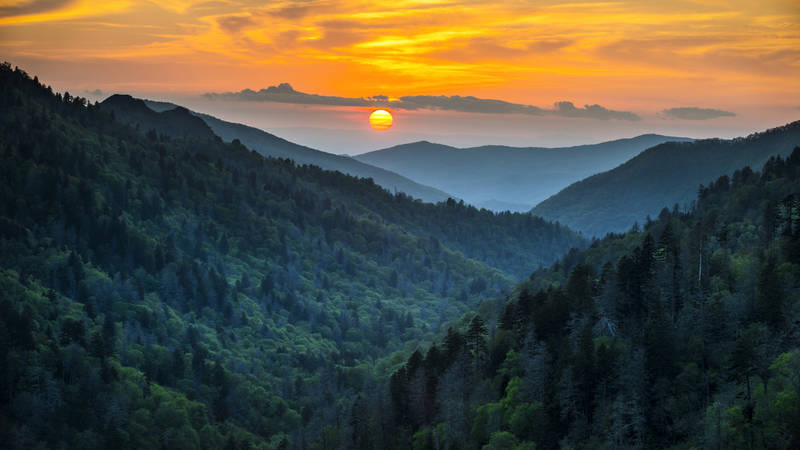The largest power company in the United States is phasing out more of its coal plants. NPCA's Don Barger explains the significance of this major victory for clean air.
In 2011, NPCA helped broker a historic agreement with the country’s largest power utility, Tennessee Valley Authority (TVA), to retrofit or retire 54 of its 59 coal-fired boilers. This agreement, known as a consent decree, is not only having a measurable impact on air quality, it’s turning out to be a smart business decision for the company. Just last month, TVA announced it will close five of the original 54 boilers ahead of schedule and retire another three instead of installing retrofit pollution controls.
NPCA’s Southeast Regional Director Don Barger answers questions on the new announcement and the long-term fight to improve air quality in the region.
Q: What is the scope of TVA’s plans to retire its boilers?

Great Smoky Mountains National Park
Great Smoky Mountains National Park is one of the country’s most popular national park sites. It offers postcard-perfect views and plentiful wildlife.
See more ›The original consent decree affected 54 of the 59 coal-fired boilers TVA has at 11 plants. Last month, TVA announced plans to shut down five boilers ahead of schedule at the Colbert Steam Plant in Alabama. Those are in our original agreement, but they’re making the decision to close them on an accelerated schedule. TVA also announced they are closing two boilers at the Paradise Steam Plant in western Kentucky and one at Widows Creek in Alabama—those three go beyond the units TVA promised to retire in the original agreement.
Q: Isn’t it unusual for a power company to go beyond a court mandate and close more units than it has to?
A: It shows the structure of the agreement we made is working. We set up a boiler-by-boiler timeline for each unit in the consent decree. TVA must make a business decision on whether to retire or retrofit each boiler by a given date. It gives TVA a lot of leeway while also setting up a court-enforceable schedule between now and 2020.
Q: Is it generally more cost-effective to shut an old plant down than install high-tech pollution controls?
Coal-generated energy has gotten increasingly more expensive in the last decade because of its rising regulatory, economic, public health, and environmental liabilities. While some owners choose to retrofit a power plant with efficient yet costly controls, others opt to invest in cleaner energy that is environmentally superior and more reasonably priced than it has been in the past. The cost-effectiveness of retiring or retrofitting is unique to each plant and ultimately a business call for the utility and consumers to make—one that must predict future markets and wager on the health of our planet.
Q: Do you have a sense of how much coal this agreement is actually reducing?
A: In 1970s, the energy that TVA produced in the Tennessee Valley was 80% coal. Their current goal through this process is to have the power for that same region be 20% coal. This kind of change is transformative on a societal level.
Q: Five years ago, one of the plants in the TVA agreement caused the biggest toxic spill by volume in U.S. history. How did this disaster happen?
A: When coal burns, you are left with solid-waste residue. If you’re burning coal at the rate that these utilities do, you get a whole lot of toxic ash. So what do you do with it? Basically, TVA built gigantic pits with levees around them to dump the ash, creating these huge structures full of slurry, a mixture of ash and water. They’re like swimming pools with millions of gallons of gray goo. These storage areas, though highly toxic, have no more regulation than household trash. No liners, inadequate monitoring.
Several years ago, the earthen dam at the Kingston Plant failed catastrophically. The 84-acre, billion-gallon pond was right on the Emory River, sending coal ash upstream. It completely wiped out life in the stream and flowed down to the Tennessee River. They are still arguing over how much stuff is in the river and whether it is toxic or just a nuisance.
Burning coal in these old, uncontrolled burners is essentially a legacy from a past way of doing things that we all recognize nowadays isn’t smart—not from an environmental, human safety, or business standpoint. Unfortunately, the fight to regulate these ash storage areas continues and to date there are still no meaningful laws governing how to dispose of coal waste.
Q: Is there a downside to moving away from coal?
A: This transformation comes at a cost. TVA is planning on ratcheting up their nuclear program. Though they’ve been doing a lot of work around renewables and energy efficiency as well.
Q: How long have you been working on this TVA agreement?

Polluted Parks: How Dirty Air is Harming America’s National Parks
“Polluted Parks” graded the pollution-related damage in the 48 national parks required by the Clean Air Act to have the highest possible air quality.
See more ›A: I’ve been working on air quality in the Smokies for 21 years, since I started at NPCA. It took the entire decade of the 90s to educate the public and decision-makers about the seriousness of air pollution at Great Smoky Mountains National Park. Fortunately, the Park Service had spent the decade before that building up the monitoring systems that essentially established the nature and degree of the problem. When I started at NPCA in 1992, park staff already had a decade of trends in data that showed the effects pollution was having: diminished visibility, foliar damage, acidification of soil, nitrogen saturation, acidification of streams, and so on. The Park Service has driven much of the clean-air debate by having good data. Ironically, those very monitors are threatened right now because of cuts to park funding.
By the end of the 90s, the EPA still hadn’t taken all the actions we’d hoped, and we made the decision to bring a lawsuit against TVA in 2000.
Q: When NPCA originally sued TVA, did you think it would end in a victory like this?
A: We assembled an amazing team of attorneys. Everyone recognized that it was a David and Goliath situation. The first discussion we had was, what would winning look like? Our answer was a global settlement. We were bringing lawsuits against specific plants for specific violations, but ultimately, what we wanted was what we got—an agreement for TVA to look at its entire fleet of boilers as a whole and commit to a declining schedule for uncontrolled burning of coal. By the time we got there, TVA also saw the wisdom in moving toward that goal. They even sent a letter to our attorneys basically saying “thank you for suing us.” By the end, it was like we were all working on this together, on the right path, doing the right thing at the right time to do it—even the CEO of TVA agreed.
Q: It sounds like attitudes around pollution have changed a great deal over time.
A: When I first started, we were regulating soot. If it wasn’t black and you didn’t see it, it wasn’t air pollution. If I had to clean it off my car, it was air pollution. Our knowledge progressed over the years to the point where we realized that a whole lot of what’s most dangerous about air pollution is not only the stuff we see, but a lot of things we can’t.
The Clean Air Act is actually designed to adapt to new science and monitor air quality to comply with these kinds of advances. Industry always says, “You’re moving the goal post on us. Tell us now, forever, and always what level of pollution is OK.” But it’s not realistic or protective of human health or the parks to do that, and it’s not the way the Clean Air Act is designed, for good reason.
Q: Can you see a visible difference in the air quality?
A: I live about 20 miles north of Knoxville and I drive in to the city each day across and through a number of mountain ridges. Interstate 75 cuts through the notch on Sharp’s Ridge, and the park’s Mount LeConte appears right in that notch. I see it every morning in exactly the same place as I have for the last 21 years. It has become my measuring stick for a clear day. When I first got into this, I thought I might never see the results. But now, in the last two or three years of driving in to work, I’ve seen Mount LeConte, even on so many summer days when the haze would once have obscured it. It feels pretty good. The air is visibly getting cleaner.
It shows the Clean Air Act is working. If we make the reductions the act calls for and we do it in a consistent way, we’ll get results.
About the author
-
 Jennifer Errick Former Associate Director of Digital Storytelling
Jennifer Errick Former Associate Director of Digital StorytellingJennifer co-produced NPCA's podcast, The Secret Lives of Parks, and wrote and edited a wide variety of online content. She has won multiple awards for her audio storytelling.
-
General
-
- NPCA Region:
- Southeast
-
Issues


